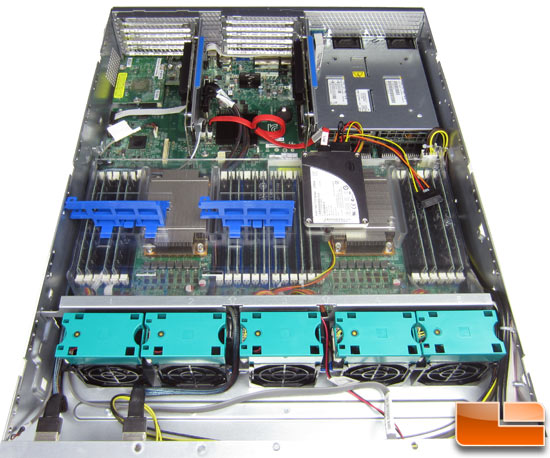Intel Xeon E5-2600 & R2000GZ Sandy Bridge-EP Server Review
Intel R2000GZ Server Specs

The Intel R2000GZ is offered in several configurations and has many additional options that can be added to any of the SKU’s. The model we received is an 8 drive, 2.5″ bay configuration with a dual layer DVD-RW drive and front I/O module. This server line is also available in 16 and 24 bay configurations for the 2.5″ form factor as well as 8 and 12 bay configurations for 3.5″ drives.

Intel has included dual hot swap, redundant 750W power supplies in the unit as can be seen above. Also included was a 2-port 10GbE module which is connected internally via a proprietary on-board connector. With 4 GbE ports on top of the 10GbE module this server has plenty of network connectivity.

Each of the drive cages in the Intel R2000GZ will carry a single 2.5″ drive. For our testing today we will be playing with a handful of Intel 710 series SSD’s in RAID 5

For testing this server was equipped with 5x Intel 710 Series 200GB SSD drives running in RAID-5. While not the most performance optimized setup, RAID-5 gives an excellent balance between speed and reliability.


Also included was an Intel Integrated RAID Module RMS25CB080 with 1GB of on-board memory. The RMS25CB080 is a 6Gb/s SATA/SAS module supporting RAID levels 0,1,5,6,10,50,6 and 60. This additional module is a hardware RAID card, meaning it uses dedicated hardware to control the array as opposed to the processing being done by the CPU via software. The biggest advantage of this type of card is performance, even with a CPU like the E5-2660 the performance hit for non simple (RAID 0/1) array is quite substantial. In addition to the performance boost you generally gain far better OS compatibility, especially when dealing with virtualization. This controller was configured in write-back mode for all testing unless otherwise noted.

Each of the Intel DPS-750XB A power supplies (P/N: E98791-005)above is rated for 750 Watts maximum and is 80+ Platinum certified.

The server has a very cooling efficient design where the air is channeled from front to back helping ensure adequate airflow. Designs such as this have become increasingly common in rack-mount servers to aid in efficient cooling. Many data-centers are moving to rack-based cooling solutions to conserve energy and to help ensure uniform inlet air temperatures to equipment. Efficient server designs are one very important piece of this puzzle.

The plastic shroud over heatsinks and memory don’t only serve as a mounting point for the Intel 710 series SSD. It also directs the air flow over the the memory and through the pair of heatsinks on the Intel Xeon E5-2660 processors. Keeping the air moving and the Intel R2000GZ server system cool is five Nidec UltraFlo V60E12BS1B5 60MM fans.

The 2.5″ drive hot-swap backplane supports up to 8 drives each. These are powered by a single 4 pin connector which in turn powers the connected drives. Two multi-port mini-SAS cables are connected each providing I/O for four SAS/SATA drives that are installed on the backplane. The thin connectors on the top corners of the backplane are for SMBus cables and are used as a management interface between the server board and the backplane(s).

The Intel S2600GZ server board features two x24 super slots that each have a riser card installed. Each of the installed riser cards feature three PCIe Gen 3 x8 slots with one as a half height slot.

Here is a better view of the Intel S2600GZ server board that powers this server. This server board has the following key features:
- Supports two Intel Xeon processor E5-2600 product family
- Models with 16 or 24 memory sockets support LR/U/R-DIMMs deliver up to 768 GB of memory capacity
- Two PCI Gen3 x 24 Super Slots for superb I/O flexibility
- Energy efficient spread core design with Intel Efficient Power Technology
- TPM header for Intel Trusted Execution Technology (Intel TXT) support
- Onboard flash boot support includes eUSB SSD and SATA DOM
- Available only as part of an integrated system: 1U and 2U options
Intel S2600GZ and S2600GL boards are only available in rack-optimized server systems in an expansive family of 1U and 2U systems for the most demanding enterprise data center, cloud, or high performance computing (HPC) environments.

Once we boot in to the Intel Grizzly Pass server BIOS the initial page gives us some basic information about the server. The Platform ID is also the motherboard model number, which happens to be the Intel S2600GZ. Below that we can see the BIOS version and build date. Just below that the total memory of 128GB is displayed. Below that we can enable or disable the Quiet Boot, POST Error Pause, and set the system date and time.

The Advanced tab of the Intel S2600GZ BIOS displays the information about our Intel Xeon E5-2660 Sandy Bridge EP processors. Each of them run at 2.2GHz and have 20MB of Cache! Below the processor information we can enable and disable several features of the processor.

While the Intel Server System R2000GZ can support up to 384GB of memory, we equipped ours with a more typical configuration of 128GB 1600MHz Registered DDR3.




Comments are closed.